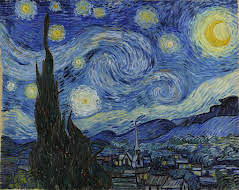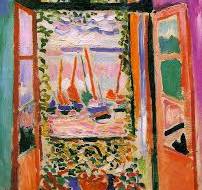The Timeless Beauty of Van Gogh’s Starry Night
Vincent van Gogh’s masterpiece, “Starry Night,” is a captivating and iconic work of art that continues to mesmerize viewers around the world. Painted in 1889 during his stay at the Saint-Paul-de-Mausole asylum in Saint-Rémy-de-Provence, France, this painting is a testament to van Gogh’s unique artistic vision and emotional depth.
The swirling night sky depicted in shades of blue and yellow, dotted with stars and a radiant crescent moon, creates a sense of movement and energy that is both dynamic and serene. The village below, with its darkened buildings and cypress trees reaching towards the sky, adds a sense of stillness and mystery to the scene.
Van Gogh’s bold brushstrokes and vibrant colors convey his emotional state at the time of painting, reflecting both his inner turmoil and his deep connection to nature. The expressive quality of “Starry Night” invites viewers to immerse themselves in the artist’s world, experiencing the beauty and wonder of the night sky through his eyes.
Over the years, “Starry Night” has become one of van Gogh’s most famous works, celebrated for its innovative style and emotional resonance. Its enduring popularity speaks to the universal appeal of van Gogh’s artistry and his ability to capture the essence of human experience through paint on canvas.
Whether viewed in person at the Museum of Modern Art in New York City or reproduced in countless prints and posters, “Starry Night” continues to inspire awe and admiration among art lovers and enthusiasts alike. Its timeless beauty transcends time and space, inviting us to contemplate the mysteries of the universe and our place within it.
Exploring the Depths of Van Gogh’s ‘Starry Night’: 8 Intriguing Insights
- Vincent van Gogh painted ‘Starry Night’ in 1889 while he was staying at the Saint-Paul-de-Mausole asylum in France.
- ‘Starry Night’ is one of Van Gogh’s most famous works and is known for its swirling brushstrokes and vibrant colors.
- The painting depicts a night sky with stars, a crescent moon, and a cypress tree in the foreground.
- Van Gogh used thick layers of paint and bold, expressive brushstrokes to create a sense of movement and emotion in the painting.
- The village depicted in ‘Starry Night’ is based on Van Gogh’s imagination rather than a specific location.
- The bright yellow stars in the painting are believed to represent hope and light amidst darkness and despair.
- ‘Starry Night’ has been interpreted as an expression of Van Gogh’s inner turmoil and struggles with mental health.
- The painting is now housed at the Museum of Modern Art in New York City.
Vincent van Gogh painted ‘Starry Night’ in 1889 while he was staying at the Saint-Paul-de-Mausole asylum in France.
Vincent van Gogh created his masterpiece “Starry Night” in 1889 during his residency at the Saint-Paul-de-Mausole asylum in France. Despite the challenges he faced during this period, van Gogh’s artistic genius shone brightly as he captured the enchanting beauty of the night sky with swirling brushstrokes and vibrant colors. This painting not only reflects van Gogh’s personal struggles but also showcases his profound connection to nature and his ability to express complex emotions through his art. The serene yet dynamic composition of “Starry Night” stands as a testament to van Gogh’s enduring legacy as a visionary artist who continues to inspire and captivate audiences worldwide.
‘Starry Night’ is one of Van Gogh’s most famous works and is known for its swirling brushstrokes and vibrant colors.
‘Starry Night’ stands out as one of Van Gogh’s most renowned masterpieces, celebrated for its mesmerizing swirling brushstrokes and vivid colors. The dynamic energy captured in the painting’s composition, with its swirling night sky and luminous stars, showcases Van Gogh’s unique artistic style and emotional intensity. This iconic artwork continues to captivate viewers with its expressive qualities and profound beauty, solidifying its place as a timeless gem in the world of art history.
The painting depicts a night sky with stars, a crescent moon, and a cypress tree in the foreground.
Vincent van Gogh’s renowned painting, “Starry Night,” skillfully captures the enchanting beauty of a night sky adorned with shimmering stars and a radiant crescent moon. The striking juxtaposition of the celestial elements against the dark backdrop creates a mesmerizing scene that evokes a sense of wonder and tranquility. The presence of a solitary cypress tree in the foreground adds a touch of mystery and depth to the composition, inviting viewers to immerse themselves in the artist’s dreamlike interpretation of the nocturnal landscape.
Van Gogh used thick layers of paint and bold, expressive brushstrokes to create a sense of movement and emotion in the painting.
Vincent van Gogh employed a distinctive technique in his masterpiece “Starry Night,” utilizing thick layers of paint and bold, expressive brushstrokes to imbue the painting with a profound sense of movement and emotion. The dynamic interplay of swirling colors and textures on the canvas not only captures the vibrancy of the night sky but also conveys the artist’s inner turmoil and intense emotional depth. Through this innovative approach to painting, van Gogh was able to infuse “Starry Night” with a sense of energy and vitality that continues to resonate with viewers, inviting them to immerse themselves in the rich tapestry of his artistic vision.
The village depicted in ‘Starry Night’ is based on Van Gogh’s imagination rather than a specific location.
In Vincent van Gogh’s masterpiece “Starry Night,” the village depicted in the painting is a product of the artist’s imagination rather than a representation of a specific real-life location. Van Gogh’s creative vision allowed him to construct a dreamlike and fantastical setting, where the village with its darkened buildings and towering cypress trees exists within the realm of his artistic expression. This imaginative approach adds an element of mystery and intrigue to the composition, inviting viewers to explore the depths of van Gogh’s mind and appreciate the boundless possibilities of his artistic interpretation.
The bright yellow stars in the painting are believed to represent hope and light amidst darkness and despair.
The bright yellow stars in Vincent van Gogh’s painting “Starry Night” are thought to symbolize hope and light shining through darkness and despair. Van Gogh, known for infusing his artwork with deep emotional meaning, likely used the stars as a metaphor for optimism and the enduring presence of beauty even in the darkest of times. The contrast between the luminous stars and the swirling, tumultuous sky creates a sense of balance and harmony, reminding viewers that there is always a glimmer of hope to be found, even in the most challenging circumstances.
‘Starry Night’ has been interpreted as an expression of Van Gogh’s inner turmoil and struggles with mental health.
Vincent van Gogh’s masterpiece, ‘Starry Night,’ has been widely interpreted as a poignant expression of the artist’s inner turmoil and his ongoing struggles with mental health. The swirling night sky, filled with tumultuous energy and vibrant colors, is often seen as a reflection of van Gogh’s emotional state at the time of painting. Through his bold brushstrokes and expressive style, van Gogh conveyed the depth of his inner struggles and the intense emotions that fueled his creative vision. ‘Starry Night’ stands as a powerful testament to the complex relationship between art and mental health, inviting viewers to delve into the artist’s psyche and experience the profound impact of his work on a deeper level.
The painting is now housed at the Museum of Modern Art in New York City.
Vincent van Gogh’s renowned masterpiece, “Starry Night,” now finds its home at the prestigious Museum of Modern Art in New York City. This iconic painting, with its swirling night sky and mesmerizing celestial elements, captivates visitors from around the world who come to witness the beauty and emotion captured by van Gogh’s brushstrokes. Displayed within the museum’s walls, “Starry Night” continues to inspire awe and appreciation, allowing art enthusiasts to experience firsthand the timeless allure of this celebrated work of art.




